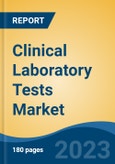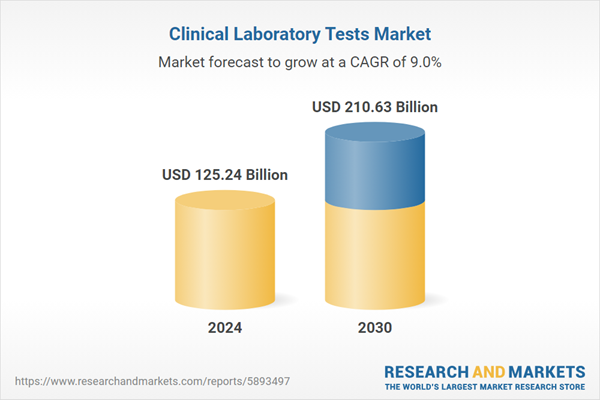Speak directly to the analyst to clarify any post sales queries you may have.
10% Free customizationThis report comes with 10% free customization, enabling you to add data that meets your specific business needs.
The market’s expansion is being fueled by a convergence of factors, including the increasing incidence of chronic diseases, continuous advancements in diagnostic technologies, and the rising adoption of personalized medicine. In recent years, clinical laboratory testing has gained significant traction due to the growing global disease burden and the healthcare industry’s strategic pivot toward early detection and preventive care.
Key Market Drivers
Increasing Prevalence of Chronic and Infectious Diseases
The surge in chronic and infectious diseases globally is a primary driver of market growth. Chronic conditions such as cardiovascular diseases, cancer, diabetes, and chronic respiratory disorders are responsible for over 41 million deaths annually, posing substantial public health and economic challenges. These statistics underscore the urgent need for early detection and continuous monitoring, where clinical laboratory tests play a critical role.As healthcare systems face mounting pressure to manage long-term disease burdens, the demand for diagnostic services continues to grow. Laboratory testing not only supports early diagnosis but also enables effective treatment planning and ongoing disease management. This trend is generating significant opportunities for diagnostic equipment manufacturers, laboratory service providers, and healthcare institutions worldwide.
Key Market Challenges
Regulatory and Compliance Complexity
One of the most significant challenges confronting the clinical laboratory tests market is navigating complex regulatory and compliance frameworks. The healthcare sector operates under rigorous standards designed to safeguard patient safety and ensure ethical practices. However, regulatory requirements often differ across countries and regions, making compliance both time-consuming and resource-intensive.Clinical laboratories, along with pharmaceutical firms, device manufacturers, and healthcare providers, must adhere to a broad range of policies and protocols. These regulations necessitate considerable investment in compliance infrastructure, personnel training, and quality assurance systems. Despite the challenges, robust regulatory adherence is essential for maintaining industry credibility and delivering safe, effective diagnostic services.
Key Market Trends
Growth of Point-of-Care Testing (POCT)
Point-of-care testing (POCT) is emerging as a transformative trend in clinical diagnostics, offering rapid and accessible testing directly at or near the site of patient care. By eliminating the need to transport samples to centralized labs, POCT enhances the speed and convenience of diagnostic workflows - especially in remote or underserved areas.Applications of POCT range from real-time infectious disease detection to chronic disease monitoring, such as blood glucose testing for diabetes. This decentralized approach enables quicker clinical decisions and more immediate treatment initiation, ultimately improving patient outcomes. As healthcare systems continue to prioritize efficiency and responsiveness, the integration of POCT technologies is expected to further reshape diagnostic practices and broaden access to care.
Key Market Players
- Quest Diagnostics Incorporated
- Abbott Laboratories Inc.
- Cinven Group
- Laboratory Corporation of America Holdings
- Arup Laboratories Inc.
- Opko Health, Inc.
- Unilabs Diagnostics AB
- Clinical Reference Laboratory, Inc.
- Synnovis Group Llp
- Sonic Healthcare Limited
Report Scope:
In this report, the Global Clinical Laboratory Tests Market has been segmented into the following categories, in addition to the industry trends which have also been detailed below:Clinical Laboratory Tests Market, By Type:
- Complete Blood Count
- HGB/HCT Testing
- Basic Metabolic Panel Testing
- BUN Creatinine Testing
- Electrolytes Testing
- HbA1c Testing
- Comprehensive Metabolic Panel Testing
- Liver Panel Testing
- Lipid Panel Testing
- Renal Panel Testing
- Cardiovascular Panel Tests
Clinical Laboratory Tests Market, By End-use:
- Central Laboratories
- Primary Clinics
Clinical Laboratory Tests Market, By Region:
- North America
- United States
- Canada
- Mexico
- Asia-Pacific
- China
- India
- South Korea
- Australia
- Japan
- Europe
- Germany
- France
- United Kingdom
- Spain
- Italy
- South America
- Brazil
- Argentina
- Colombia
- Middle East & Africa
- South Africa
- Saudi Arabia
- UAE
Competitive Landscape
Company Profiles: Detailed analysis of the major companies present in the Global Clinical Laboratory Tests Market.Available Customizations:
With the given market data, the publisher offers customizations according to a company's specific needs. The following customization options are available for the report.Company Information
- Detailed analysis and profiling of additional market players (up to five).
This product will be delivered within 1-3 business days.
Table of Contents
Companies Mentioned
- Quest Diagnostics Incorporated
- Abbott Laboratories Inc.
- Cinven Group
- Laboratory Corporation of America Holdings
- Arup Laboratories Inc.
- Opko Health, Inc.
- Unilabs Diagnostics AB
- Clinical Reference Laboratory, Inc.
- Synnovis Group Llp
- Sonic Healthcare Limited
Table Information
| Report Attribute | Details |
|---|---|
| No. of Pages | 180 |
| Published | April 2025 |
| Forecast Period | 2024 - 2030 |
| Estimated Market Value ( USD | $ 125.24 Billion |
| Forecasted Market Value ( USD | $ 210.63 Billion |
| Compound Annual Growth Rate | 9.0% |
| Regions Covered | Global |
| No. of Companies Mentioned | 10 |









